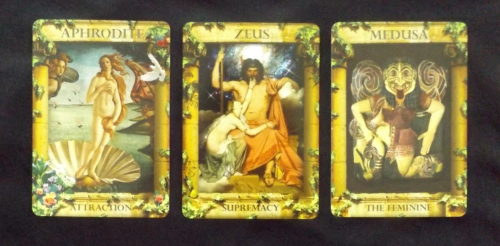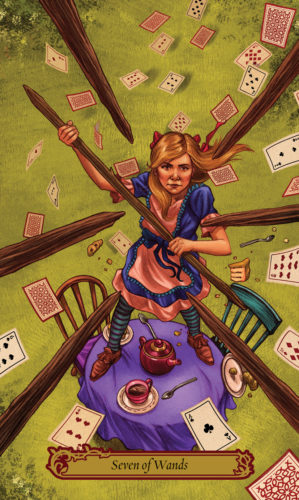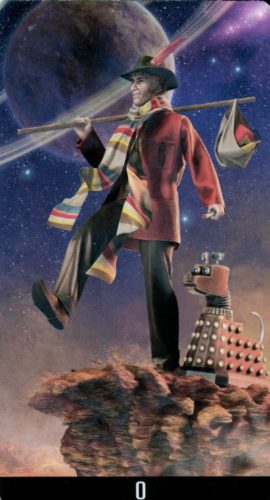Zeus, Dr. Who, Alice in Wonderland, Medusa, those Sex and the City gals, and manga-influenced art are featured in new tarot decks. Here’s a look.
Mystical Manga Tarot
Barbara Moore, illustrated by Rann, 78 cards, 175-page book (Llewellyn).
Barbara Moore calls herself a “tarot shaman” and says she uses the cards to explore “the magic and mystery of everyday life.”
She’s also the co-creator, with various artists, of Tarot in Wonderland, Cats Inspirational Oracle Cards, Earth Wisdom Oracle, the Gilded Tarot, Hip Witch Tarot Kit, Steampunk Tarot, the Vampire Tarot of Eternal Night, and other decks.
“A shaman is someone who, among other things, travels to worlds in non-ordinary reality to search for wisdom and guidance,” Moore writes on her website. “Shamans work with helping spirits and teachers, seeking to bring healing to the people they serve. While I am certainly not a traditional shaman, the work I do with tarot and the way I approach life is similar and incorporates shamanistic practices.”
In line with her steampunk, vampire and hip witch decks, Moore continues her tradition of mashing up pop culture and traditional tarot with Mystical Manga Tarot. French illustrator Rann uses the style of manga — those Japanese graphic novels and comics that feature sharp-chinned, pale-skinned, always-youthful characters — to render a deck that mirrors traditional Rider-Waite imagery. Even the hermit and the devil (a Pan-looking satyr) appear no older than 19.

From the Mystical Manga Tarot, from left: the fool, death, the devil, and the star [courtesy].
The deck’s book, however, is more than a collection of card descriptions and divinatory meanings. 48 pages are devoted to how to work with the cards. A basic tarot glossary and a question-and-answer section are user-friendly enough for first-time tarot users. The questions include, “Can I use the tarot to spy on my ex or tell me if my boyfriend is cheating on me?” and, “Will cards show if someone is going to die?”
A lengthy how-to section includes six sample spreads and tips such as, “[p]retend a celebrity has asked for a reading and practice on them.”
The major arcana is described as “a map of a journey of enlightenment” as seen through the eyes of the fool. All descriptions of the 22 major arcana cards relate each card to the fool and his journey. “If the fool knew that death followed the hanged man, he might not have had the courage to live his beliefs so fully,” reads the segment on the death card.
The star description reads: “The fool’s commitments have been tested both internally and externally and, to tell you the truth, he feels pretty battered and worn out. Luckily he gets to visit the star.”
On the Llewellyn website, Moore says that the Mystical Manga Tarot “would be an ideal beginner deck.” Experienced tarot aficionados should find plenty in the deck to engage themselves, too.
Greek Mythology Reading Cards
Alison Chester-Lambert, illustrated by Richard Crookes, 50 cards, 112-page book (Findhorn Press).

From the Greek Mythology Reading Cards, from left: Aphrodite, Zeus, and Medusa [courtesy].
Yes, a university degree in astrology. The school’s website says it “is the only academic degree in the world to examine our relationship with the cosmos.”
“The stories of ancient Greece gave its people their history, moral principles, laws, and their spiritual support,” Chester-Lambert writes in the deck’s small-sized guide booklet. “The different aspects of human nature and human experience all had accompanying gods and goddesses that could be learned from or consulted.
“Deities could be implored for support and guidance in times of stress, so if you suspected a lover of infidelity, you could consult Hera for help. If you needed strength in a task, Athena might assure you of victory. Perhaps Eros would tell of a passionate new relationship, or we might seek the supremacy and confidence of Zeus.
“The ancient Greek deities are still embedded in our world; we just stopped recognizing and crediting them. Perhaps using these cards will bring them into consciousness again, for their influence could be as powerful today as it was then.”
The Greek mythology deck is not based on a traditional tarot format. Instead of 22 trumps and 56 minor arcana cards, the set consists of 50 cards featuring gods, goddesses, heroes and other mythological figures. Illustrator Richard Crookes rendered the collages of images by digitally reworking public-domain photographs of classical and some modern artworks found in museums in Athens, Berlin, Naples and other cities around the world, from the Louvre to the Los Angeles County Museum of Art.
Some of the art is well known: Botticelli’s The Birth of Venus, Jean-Auguste-Dominique Ingres’s Jupiter et Thetis, John Singer Sargent’s Hercules.
Chester-Lambert pairs the mythological figures with an array of emotions, psychological states and concepts. The familiar deities mostly get the card they deserve: Ares is “warmongering,” Orpheus is “music,” Hermes is “journey,” Aphrodite is “attraction,” Dionysus is “merrymaking,” and Zeus is “supremacy,” for example.
Surprisingly, Medusa — which takes its image from a restored Gorgon from the temple of Athena in Syracuse circa 570-550 B.C.E. — is called “the feminine.” In the deck’s booklet, Chester-Lambert writes: “Medusa was one of three frightening Gorgons, or female demons, with live snakes for hair. . . . Myth says that the sight of her stare will turn a human into stone.”
She relates the tale of Perseus, who cut off Medusa’s head and kept it to use its stare against his enemies.
“The card implies that you may summon the power and magic of the primordial feminine or foddess power to help and strengthen you now,” Chester-Lambert concludes.
Other cards may send readers to a reference work to discover more about such lesser-known mythical figures as Alcmene (“unfairness”), Creusa (“secrets”), and Ouranus (“remoteness”).
Chester-Lambert provides only threadbare directions for reading techniques: less than two pages. She cites “the traditional Celtic cross layout” without detailing it. Those seeking more refined reading techniques will have to look elsewhere.
Tarot in Wonderland
Barbara Moore, illustrated by Eugene Smith, 78 cards, 360-page book (Llewellyn).

The Seven of Wands from Tarot in Wonderland [courtesy].
“The images remain true to the Rider-Waite-Smith cards and will feel familiar to many readers,” the prodigious Moore writes. “Blending the traditional images with another well-loved work of art, the Alice stories, gives the cards a fresh feel. They are recognizable yet very different, creating a dreamlike sensation.
“This sense of strange familiarity creates a perfect state for divination. In readings, we want to find the truth and wisdom that has eluded us. To do that, we need to see differently. Tarot in Wonderland is a lens that helps us do that.”
That hookah-smoking caterpillar as the magician, anyone?
TV Series Tarot
Gero Giglio, 78 cards. 64-page book (Llewellyn).

Dr. Who is the Fool in the TV Series Tarot [courtesy].
That leads to a tricky but intriguing proposition: do a reading with the TV Series Tarot in order to ask the cards to identify themselves.
The Wild Hunt is not responsible for links to external content.
To join a conversation on this post:
Visit our The Wild Hunt subreddit! Point your favorite browser to https://www.reddit.com/r/The_Wild_Hunt_News/, then click “JOIN”. Make sure to click the bell, too, to be notified of new articles posted to our subreddit.